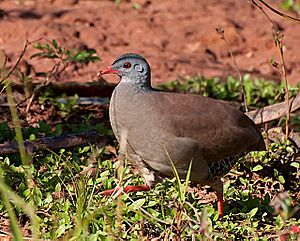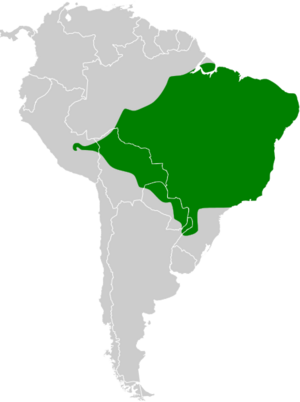Small-billed tinamou facts for kids
Quick facts for kids Small-billed tinamou |
|
|---|---|
 |
|
| Conservation status | |
| Scientific classification | |
| Genus: |
Crypturellus
|
| Species: |
parvirostris
|
 |
|
The small-billed tinamou (Crypturellus parvirostris) is a special kind of bird called a Tinamou. You can often find it living in dry savanna areas within the Amazon region of South America.
Contents
About the Small-Billed Tinamou
The small-billed tinamou is a fairly small bird, usually about 22 cm (8.7 in) long. Its top feathers are dark brown. The feathers on its belly and head are a grayish or brownish color. It has a bright red beak and red legs, which help it stand out!
Bird Family and History
The small-billed tinamou is the only type of its species. All tinamous belong to the Tinamidae family. These birds are also part of a larger group called ratites. Other ratites include ostriches and emus, which are known for not being able to fly.
However, tinamous are different! They can fly, even though they aren't super strong flyers. Scientists believe that all ratites, including tinamous, came from ancient birds that could fly. Tinamous are thought to be the closest living relatives to these very old flying birds.
What's in a Name?
The scientific name for the small-billed tinamou is Crypturellus parvirostris. The first part, Crypturellus, comes from three Latin or Greek words:
- kruptos means covered or hidden
- oura means tail
- ellus means small
So, Crypturellus basically means "small hidden tail." This name fits because their tails are quite short and often tucked away!
Life Cycle and Habits
Like other tinamous, the small-billed tinamou finds most of its food on the ground. They love to eat fruits that have fallen from trees or grow on low bushes. They also snack on small amounts of invertebrates (like insects), flower buds, soft leaves, seeds, and even roots.
When it comes to raising a family, the male tinamou does most of the work! He incubates the eggs, which can come from as many as four different females. After the chicks hatch, he takes care of them until they are old enough to live on their own, usually in about two to three weeks. Their nests are built on the ground, often hidden in thick bushes or between the raised roots of large trees.
Could They Be Pets?
People have thought about raising small-billed tinamous on farms. This is because these birds can lay eggs and raise young three to four times a year. They are also quite strong and don't get sick easily from diseases that affect other farm birds like chickens.
Where They Live
The small-billed tinamou prefers dry savanna areas. However, you might also find them in lowland areas with lots of shrubs. Their home is mainly in the Amazon region of South America. This includes most of Brazil (except the southeast), northeastern Peru, eastern Bolivia, Paraguay, and northeastern Argentina.
Looking After Them
The IUCN (International Union for Conservation of Nature) keeps track of how many small-billed tinamous there are. They have classified this bird as "Least Concern." This means there are still plenty of them around, and they are not currently in danger of disappearing. Their habitat covers a huge area, about 6,700,000 km2 (2,600,000 sq mi)!


